
Borneo is the third-largest island in the world and the largest in Asia. At the geographic centre of Maritime Southeast Asia, in relation to major Indonesian islands, it is located north of Java, west of Sulawesi, and east of Sumatra.
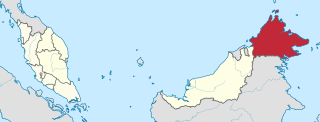
Sabah is a state of Malaysia located on the northern portion of Borneo, in the region of East Malaysia. Sabah has land borders with the Malaysian state of Sarawak to the southwest and Indonesia's Kalimantan region to the south. The Federal Territory of Labuan is an island just off the Sabah coast. Sabah shares maritime borders with Vietnam to the west and the Philippines to the north and east. Kota Kinabalu is the state capital city, the economic centre of the state, and the seat of the Sabah state government. Other major towns in Sabah include Sandakan and Tawau. The 2015 census recorded a population of 3,543,500 in the state, and in 2019 it was estimated to have grown to over 3.9 million. Sabah has an equatorial climate with tropical rainforests and abundant animal and plant species. The state has long mountain ranges on the west side which forms part of the Crocker Range National Park. Kinabatangan River, the second longest river in Malaysia runs through Sabah, and Mount Kinabalu is the highest point of Sabah as well as of Malaysia.
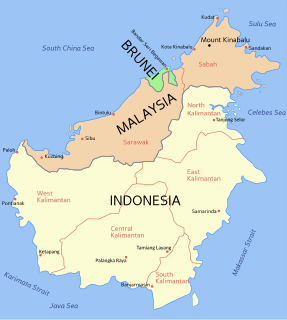
East Malaysia, also known as Sabah, Sarawak and Labuan or Malaysian Borneo, is the part of Malaysia on and near the island of Borneo, the world's third largest island. It consists of the Malaysian states of Sabah and Sarawak, as well as the Federal Territory of Labuan. Labuan is an island in a small archipelago near the coast of Sabah. East Malaysia lies to the east of Peninsular Malaysia, the part of the country on the Malay Peninsula. The two are separated by the South China Sea.

Kuih are bite-sized snack or dessert foods commonly found in Southeast Asia. It is a fairly broad term which may include items that would be called cakes, cookies, dumplings, pudding, biscuits, or pastries in English and are usually made from rice or glutinous rice. The term kuih is widely used in Malaysia, Brunei, and Singapore, and kueh or kue is used in Indonesia, to refer to sweet or savoury desserts. Though called by other names, one is likely to find various similar versions of kuih in neighbouring countries, such as Vietnam, Thailand, and Myanmar. For example, the colourful steamed kue lapis and the rich kuih bingka ubi are also available in Myanmar, Thailand, and Vietnam. In the Philippines, kuih are referred to in Tagalog as kakanin.

Victoria, sometimes known as Bandar Labuan, is the capital of the Federal Territory of Labuan in Malaysia, an island group off the north coast of Borneo. It is in the southeast corner of Labuan and its Malay name, Bandar Victoria, is commonly used in honour the reign of Queen Victoria. The town is an urban district within the wider city limits of Victoria which includes Labuan Port, a sheltered deep-water harbour which is an important trans-shipment point for Brunei Darussalam, northern Sarawak and western Sabah.
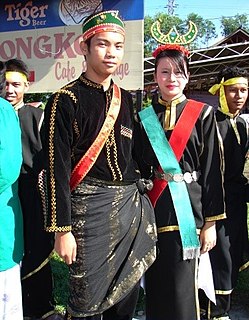
Bisaya is an indigenous people from the northwest coast of East Malaysia on the island of Borneo. Their population is concentrated around Beaufort, Kuala Penyu, Menumbok, Sipitang, Labuan Federal Territory and in Limbang District, Sarawak. The Bisaya tribe has many similarities with the Dusun Tatana tribe, especially in terms of language. It is evident that some of their dialogical language conversations are almost identical if they have a dialogue with each other. Nowadays the Bisaya living in Sabah are Muslim, while the Bisaya living in Sarawak are mostly Christian. In Brunei, they are referred as Dusun, Jati Dusun and Bisaya. The Bisaya is closely related, linguistically, with the Tatana Dusun of Kuala Penyu, Sabah. The Bisaya people are also regarded as a relatives of the Dayak people whereas Bisaya was not brought into Borneo instead they are aboriginal of the land.

Kue kochi or koci is a Maritime Southeast Asian dumpling found in Javanese, Malay and Peranakan cuisine, made from glutinous rice flour, and stuffed with coconut fillings with palm sugar.

Bruneian Malays are a native Malay ethnic group that lives in Brunei, the federal territory of Labuan, the southwestern coast of Sabah and the northern parts of Sarawak. The Bruneian Malays are a subgroup of the larger ethnic Malay population found in the other parts of the Malay World, namely Peninsular Malaysia and the central and southern areas of Sarawak including neighbouring lands such as Singapore, Indonesia and Southern Thailand, having visible differences especially in language and culture, even though they are ethnically related to each other and follow the teachings of Islam. All Bruneian Malays who are born or domiciled in East Malaysia even for generations before or after the independence of the states of Sabah and Sarawak from the British Empire through the formation of Malaysia in 1963 are also considered Malaysian Malays in the national census and were in the same status like the Malaysian Malays domiciled in Peninsular Malaysian states and the central and southern parts of Sarawak. They are also defined as a part of the Bumiputera racial classification together as a subgroup within the Malaysian Malay ethnic population along with the Kadazan-Dusuns, Ibans, Malaccan Portuguese and the Malaysian Siamese.

Cincin is a traditional kuih for the Bruneian Malay people in the states of Sabah, Malaysia as well in Brunei.

Kelupis is a traditional kuih for the Bruneian Malay people in the country of Brunei and in the states of Sabah and Sarawak in Malaysia. It is also a traditional snack for the Bisaya people as the three ethnics are ethnically related which is Lun Bawang/Lundayeh also create this kelupis especially on the wedding ceremony.

Clorot, celorot, cerorot, or jelurut is an Indonesian traditional sweet snack of sweet and soft rice flour cake with coconut milk, wrapped with janur or young coconut leaf in cone shape. It is a popular traditional sweet snack commonly found in Indonesia, Malaysia and Brunei.

Jala is a traditional kuih from Sabah and Sarawak in Malaysia and Brunei. In Sarawak, it is known as the traditional snack for the Iban people. It is very different from the roti jala in Peninsular Malaysia.

Apam balik, also known as terang bulan, martabak manis or mànjiānguǒ, is a dessert common in many varieties at specialist roadside stalls throughout Brunei, Indonesia, Malaysia and Singapore.

Kue semprong, Asian egg roll, sapit, sepit, kue Belanda, or kapit, is an Indonesian traditional wafer snack made by clasping egg batter using an iron mold which is heated up on a charcoal stove. It is commonly found in Indonesia, Malaysia, Singapore and Brunei.
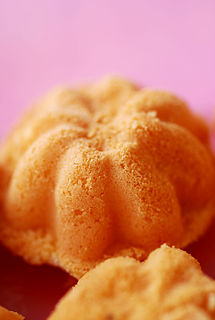
Bahulu or baulu is a traditional Malay pastry (kue/kuih). It is similar in concept to the madeleine cake, but round in shape and composed of different ingredients. There are three versions available, the most common being bahulu cermai (star-shaped) and the more elusive bahulu gulung and bahulu lapis (layered). Bahulu is believed to be originated in Malay Peninsula during the colonization era and is the corruption of the Malaccan Kristang word, bolu which means cake. It is usually served during Eid al-Fitr as well as during the Chinese New Year.

Kuih lidah is a traditional kuih for the Bruneian Malay people in Papar in the states of Sabah in Malaysia.

Dadar gulung is a popular traditional kue of sweet coconut pancake. In Malaysia, Singapore and Brunei, it is called as Kuih Ketayap or Kuih Lenggang or Kuih Dadar. In Indonesia, it is called dadar gulung, often described as an Indonesian coconut pancake. It is commonly found in Brunei, Indonesia, Malaysia, Singapore and Sri Lanka.
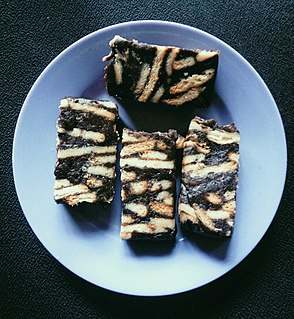
Batik cake is a type of Malaysian fridge cake dessert inspired by the tiffin, brought in the country by the British during the colonial era, and adapted with Malaysian ingredients. This cake is made by mixing broken Marie biscuits combined with a chocolate sauce or runny custard made with egg, butter/margarine, condensed milk, Milo and chocolate powders. The cake is served during special occasions like the Eid al-Fitr and Christmas.
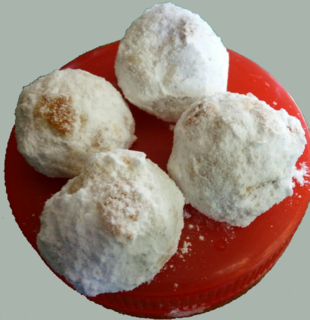
Kue makmur is a traditional Malay kue or kuih. This cake made from butter, ghee and flour, and served during special occasion of Eid al-Fitr. Kue makmur is identified with its white colour and usually in a round shape.

The Lahad Datu District is an administrative district in the Malaysian state of Sabah, part of the Tawau Division which includes the districts of Kunak, Lahad Datu, Semporna and Tawau. The capital of the district is in Lahad Datu Town.




















